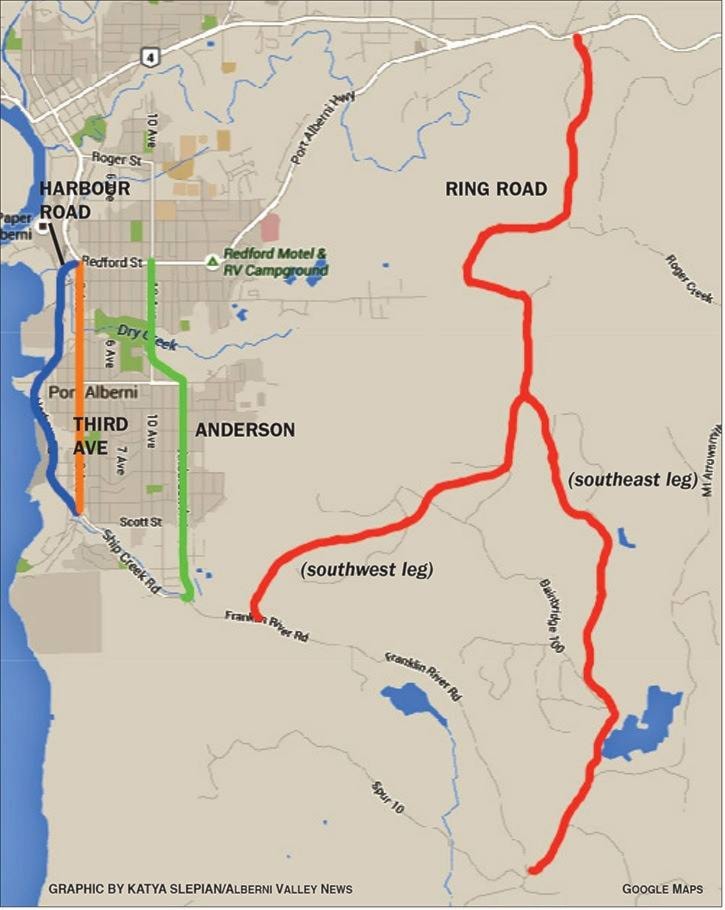Years of debate about industrial trucks in Port Alberni has led to an impasse, as city council voted Feb. 19 to move the issue to a “low priority” on their status report.
In late 2015, city staff came up with a list of options for a designated truck route in Port Alberni, in response to concern from Third Avenue businesses and Anderson Avenue residents who do not want heavy industry traffic on their roads. Options included a $10 million waterfront industrial route and a $20 million Ring Road outside of city limits.
READ: TRUCK TALK: The truck stops here
According to director of development services Scott Smith, the price was a challenge for council.
“There was a lot of work that was done, but the cost is significant,” he said during a budget meeting on Thursday, Feb. 1. “We’re taking a step back. What sort of volume of traffic are we talking about? Is there a way we can consider a truck route that isn’t $10 million?”
City staff completed a truck count in 2017, looking at all vehicles in multiple locations over three days. This resulted in 1,500 pages worth of data.
READ: Alberni city staff to take on truck count
Smith proposed a study that would take this data, crunch the numbers, do some analysis and come up with improvements for the city’s road infrastructure for a potential truck route—one that is not in the multi-million-dollar range.
Smith confirmed that a consultation would look at options “within the existing road infrastructure,” which would be primarily the Harbour Road waterfront route. The city acquired a portion of Harbour Road, as well as a statutory right of way from Redford Street, when they purchased the Catalyst lagoon.
This consultation would cost approximately $40,000, but council voted down the motion in the 2018-2022 draft financial plan.
“We’ve done a truck count I don’t know how many times,” said Councillor Jack McLeman. “[With] this money, there’s going to be another consultant that’s going to look at the stuff we’ve already got. I think we’re going around this thing in circles forever.”
Councillor Sharie Minions took issue with Port Alberni’s “vibrant waterfront” being interrupted by a truck route.
“I’m strongly opposed to spending any money that’s going to move us towards putting more heavy industry trucks on our waterfront,” she said. “I don’t think that alleviates the problem of having them on Third and Anderson.”
With no money invested in the next step of the project, it came to a halt during last Monday’s meeting of council.
“It’s been dealt with to the extent that we can,” said Smith.
Minions suggested removing the item from council’s status report, or setting it to a low priority. “We did not support funding to take it forward,” she said. “Having it on there as a high priority if we didn’t put funds forward just seems kind of pointless.”
Councillor Ron Paulson did not want to take the item off entirely.
“As a council, we’ve indicated to the businesses on Third Avenue and the people on Anderson that we would look into this,” said Paulson. “To be quite honest, I think that we need to find a solution.”
Because the item is tied up in budget discussions, council agreed to set it to a low priority for now.
But discussion of truck traffic in the Alberni Valley has not come to a halt. In a later interview, Councillor Chris Alemany made some suggestions for reducing the impact of truck traffic on city streets.
“If we can limit and direct where heavy truck traffic goes, we can limit the wear and tear on the roads,” he said.
The city did this once before, by putting a weight restriction on the Gertrude Street bridge so that trucks are kept to Beaver Creek Road.
Alemany pointed out that Port Alberni also has a major highway running through the community that is funded by the provincial government, rather than city taxpayers.
“Unfortunately, that doesn’t help the Anderson and Third Avenue situation,” he added.
There are traffic calming measures that can be applied to residential roads, to keep trucks from travelling as fast as they have been. The city can enforce lower speed limits or add speed humps, as has been suggested by Anderson residents. But, said, Alemany, these are somewhat drastic steps. Engineering measures, such as lane narrowings and curb extensions, can also calm traffic.
“It encourages people to actually stop, and makes it safer for pedestrians to cross,” said Alemany. “It’s worth having that public discussion.”
There are longer-term solutions for trucks in the Alberni Valley that also keep them away from the waterfront, such as a bypass outside of the city, or a revival of the rail system, but these measures are within tens of millions of dollars.
“Those are larger solutions that would require some provincial help,” said Alemany.
